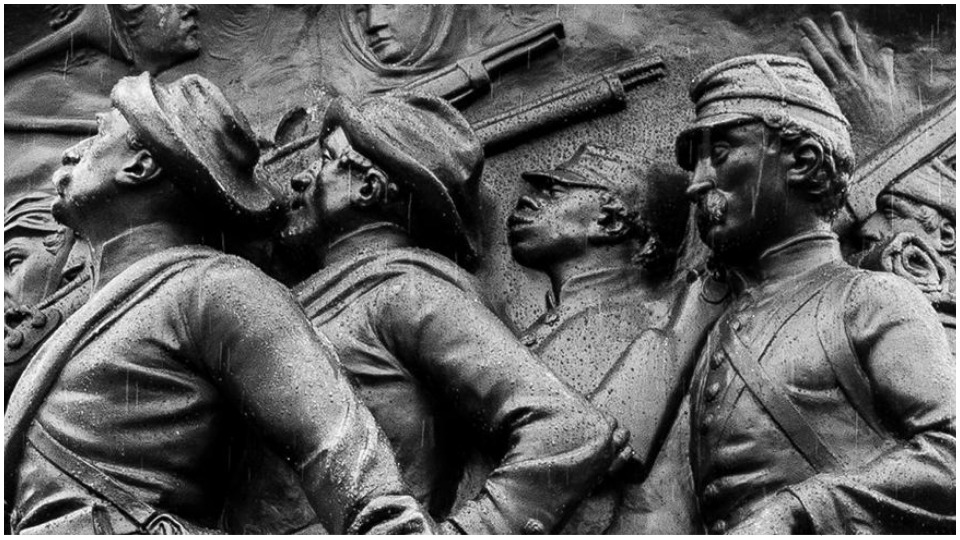
My mother recently moved into an assisted living facility, and some of her possessions were moved to my house, including boxes of photos. Among them, I discovered a photo from when I was 5 years old, when my grandparents had taken us to see a statue sculpted by a man they referred to as our “Uncle Moses Ezekiel” (turns out he was actually my first cousin four times removed). Moses was one of the first famous Jewish artists in the United States, and my grandparents were proud of him. The photo shows my brothers and me, looking hot and bored, in front of his monumental 32-foot-high statue: the Arlington National Cemetery’s Confederate Memorial.
Around the base is a frieze showing Southern soldiers, and most egregious, two African Americans, one dubbed a “mammy” holding a white baby, crying as the men go off to war. The other depicts an enslaved man, no doubt accompanying his owner—an image often used to bolster the myth of the “Black Confederate.” This statue, still standing, suggests that enslaved people were complicit in their own slavery. Even worse, I now know, is that the statue was commissioned—not at the end of the Civil War—but 50 years later in the 1910s by a group called the United Daughters of the Confederacy.
The UDC, a part of Southern white women’s active campaign to perpetuate racist hatred and white supremacy, was founded in 1894, reached 80,000 members in 1912, and raised hundreds of thousands of dollars with the purpose of rehabilitating the Confederacy. According to one historian, “For nearly twenty years, the Daughters successfully campaigned to build monuments in almost every city, town, and state of the former Confederacy,” including at least one in commemoration of the Ku Klux Klan.

Nearly all Confederate statues in the United States were erected after 1895, the vast majority between 1900 and the 1920s, a high point of racist violence and oppression (the KKK had 5 million members in 1925). There was a resurgence in building again during the Civil Rights Movement. Today, even with some having come down, there are still about 1,700 Confederate symbols on public land, and some 700 of them are monuments. Most are in the South, but not all. There are monuments around the country, including several in my home state of Ohio; one of them, on Johnson Island, is also by “Uncle” Moses Ezekiel.
The Arlington Cemetery statue had faded from my memory until 2017, when Nazis and white supremacists rallied in Charlottesville around a statue of Thomas Jefferson, chanting “White lives matter,” and “Jews will not replace us.” It was brought to my attention that, ironically, that statue was sculpted by a Jew, my cousin Moses.
I immediately started a discussion with my family about the Arlington Memorial, and in 24 hours over five time zones we got 22 members of our extended family, aged 19-91, to sign a letter demanding the removal of our relative’s statue. Since then, another 18 of Moses’s relatives have joined us from four or five branches of our family tree. It has been reproduced in the Washington Post and in newspapers from France to New Zealand, dovetailing with campaigns by descendants of Stonewall Jackson and Robert E. Lee, all proclaiming that Confederate monuments have no right to occupy our public spaces.
Here is the text of our letter:
One of the most important memorials to the Confederacy is the statue at Arlington National Cemetery, unveiled in 1914. It was sculpted by Moses Jacob Ezekiel, a former Confederate soldier and a prominent sculptor of his time. Ezekiel was our relative.
Like most such monuments, this statue intended to rewrite history to justify the Confederacy and the subsequent racist Jim Crow laws. It glorifies the fight to own human beings, and, in its portrayal of African Americans, implies their collusion.
As proud as our family may be of Moses’s artistic prowess, we—more than twenty members [now 40] of the Ezekiel extended family—say remove that statue. Take it out of its honored spot in Arlington National Cemetery and put it in a museum that makes clear its oppressive history.
Confederate monuments are not memorials to the fallen soldiers or to the victims of war: They are intentional instruments in revisionist U.S. history that portrays a sympathetic view of the Confederacy and the idea of the “Lost Cause,” a sort of Gone-With-the-Wind view of the era.
“The Lost Cause” created a legend to absolve the South of any blame in the Civil War and in slavery. It portrays Confederate soldiers as tragic yet heroic figures who failed only because of the superior firepower of the North. It contends that the enslaved people were not mistreated and were actually rather happy with their lot. It claims that the cause of the Civil War was not slavery but “states’ rights” (a code word still today for racism). Although nearly all historians concur that slavery was at the heart of the War, over 40% of Americans today don’t believe it. And finally, and less frequently noted, the Lost Cause portrays a culture based upon white male protection of pure Southern white womanhood. The Lost Cause is white supremacy in its most concentrated form.
Former Mayor of New Orleans Mitch Landrieu declared, upon removing several monuments in his city, that “the ‘false narrative’…of the ‘Cult of the Lost Cause’….had one goal…to rewrite history to hide the truth, which is that the Confederacy was on the wrong side of humanity.”
Promoting the Lost Cause, flying Confederate flags, erecting and maintaining these monuments were all reflections of, and instruments in bolstering racist Jim Crow laws, later of opposing the Civil Rights Movement, and today of reinforcing white supremacy. This is a war of ideas, a culture war, and we must fight back.
We are already fighting back in the Black Lives Matter movement, but may I suggest a few small actions we might take. We can sign the petitions to change the name of the Edmond Pettus Bridge, named after a former Grand Dragon of the KKK, to honor Rep. John Lewis, Amelia Boynton, or one of the martyrs of Selma’s Bloody Sunday. We can call our representatives and senators to support a bill in Congress called “The Confederate Monument Removal Act,” first introduced by Cory Booker and Barbara Lee. And we can organize to take down the monuments in our regions.
I conclude with an excerpt from a recent opinion piece by African-American poet Caroline Randall Williams:

“I have rape-colored skin. My light-brown-blackness is a living testament to the rules, the practices, the causes of the Old South. If there are those who want to remember the legacy of the Confederacy, if they want monuments, well, then, my body is a monument. My skin is a monument….”
She continues, “I am more than half white, and none of it was consensual. White Southern men—my ancestors—took what they wanted from women they did not love, over whom they had extraordinary power, and then failed to claim their children.”
“What is a monument but a standing memory?” she asks. “An artifact to make tangible the truth of the past. My body and blood are a tangible truth of the South and its past. The Black people I come from were owned by the white people I come from. The white people I come from fought and died for their Lost Cause. And I ask you now, who dares to tell me to celebrate them? Who dares to ask me to accept their mounted pedestals?”
She concludes that as a great-great-granddaughter of Confederates, “the monuments of stone and metal, the monuments of cloth and wood, all the man-made monuments, must come down. I defy any sentimental Southerner to defend our ancestors to me. I am quite literally made of the reasons to strip them of their laurels.”
This article is adapted from an address delivered at the Yellow Springs Black Lives Matter Protest on July 5, 2020.

MOST POPULAR TODAY


Zionist organizations leading campaign to stop ceasefire resolutions in D.C. area

High Court essentially bans demonstrations, freedom of assembly in Deep South

Communist Karol Cariola elected president of Chile’s legislature

Afghanistan’s socialist years: The promising future killed off by U.S. imperialism






Comments